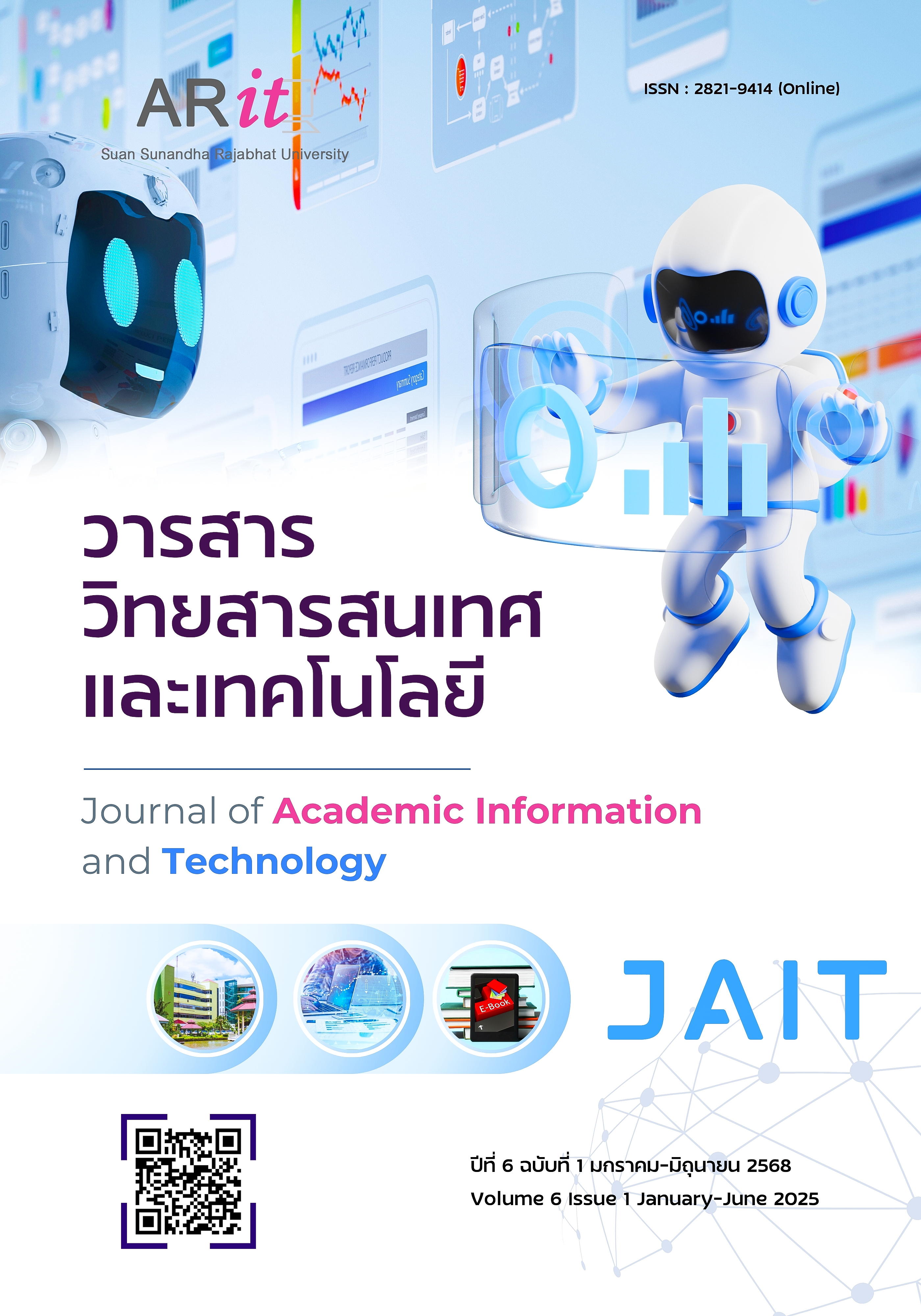Classroom Monitoring Systems Via the Internet of Things
Keywords:
Classroom, Internet of Things, Monitoring, PM2.5 ParticulatesAbstract
The research presented in this study focuses on the development of an environmental monitoring system and classroom usage through the Internet of Things (IoT). A total of 10 monitoring units were created to assess the classroom environments within the Faculty of Technology and Management at King Mongkut's University of Technology North Bangkok, Prachinburi Campus, covering 10 classrooms during the first semester of the academic year 2023, from July to October 2023. The system recorded environmental factors during classroom usage, including temperature, humidity, and PM2.5 particulate matter levels, to determine whether the classrooms provided a suitable learning environment. The system categorises air quality into three levels based on PM2.5 concentrations: Level 1 (Fresh Air) indicates excellent air quality with PM2.5 not exceeding 15.0 µg/m³; Level 2 (Moderate Air) reflects moderate air quality with PM2.5 between 15.0–25.0 µg/m³; and Level 3 (Unhealthy) denotes poor air quality with PM2.5 exceeding
25 µg/m³. The findings revealed that eight classrooms maintained an average PM2.5 level classified as Level 1 (excellent air quality), while two classrooms were rated as Level 2 (moderate air quality). All monitored classrooms were equipped with air conditioning, ensuring that temperature and humidity levels remained within appropriate ranges, and lighting conditions were also deemed suitable across all ten classrooms. Additionally, a dashboard interface was developed to display environmental data via a website and to log this information in a database for future analysis regarding classroom suitability and usage timings.
References
กรมควบคุมมลพิษ. (2566, 5 กรกฎาคม). ประกาศดัชนีคุณภาพอากาศของประเทศไทย พ.ศ. 2566. https://www.pcd.go.th/pcd_news/30028
ถิรพิรุฬห์ ทองคำวิฑูรย์. (2559). เทคโนโลยี Internet of things และข้อเสนอแนะในการบริหารคลื่นความถี่ในประเทศไทย. วารสารกิจการสื่อสารดิจิทัล, 1(1), 167-194. https://so04.tci-thaijo.org/index.php/NBTC_Journal/article/view/118710
น้ำผึ้ง สายหงส์ และอวิรุทธ์ ศรีสุธาพรรณ. (2550). แนวทางการออกแบบแสงสว่างในห้องเรียนสื่อผสม. วารสารวิจัยและสาระสถาปัตยกรรม/การผังเมือง, 5(1), 67-81. https://doi.org/10.56261/jars.v5i1.169218
ปมณฑ์ ภูมาศ. (2564). การตรวจสอบคุณภาพอากาศในห้องเรียนบางห้องของคณะวิทยาศาสตร์และเทคโนโลยี มหาวิทยาลัยราชภัฏเชียงใหม่. วารสารวิทยาศาสตร์และเทคโนโลยี, 29(1), 91-100. https://doi.org/10.14456/tstj.2021.8
ปัทมพร กิตติก้อง, พรพรรณ สกุลคู, กิตศราวุฒิ ขวัญชารี และกันณพงศ์ อัครไชยพงศ์. (2560). การศึกษาระดับความเข้มแสงสว่างในห้องเรียนและลักษณะทางกายภาพของห้องที่มีผลต่อความรู้สึกเมื่อยล้าทางสายตาของนักเรียน กรณีศึกษา: โรงเรียนประถมศึกษาแห่งหนึ่ง จังหวัดขอนแก่น. วารสารสำนักงานป้องกันควบคุมโรคที่ 7 ขอนแก่น, 24(3), 10-18. https://he01.tci-thaijo.org/index.php/jdpc7kk/article/view/162443
มินตรา ผาระสิทธิ์ และธัญญรัตน์ ไชยคราม. (2563). การประยุกต์ภูมิสารสนเทศเพื่อการประเมินคุณภาพอากาศในพื้นที่กรุงเทพมหานคร. วารสารวิทยาศาสตร์และเทคโนโลยี, 28(5), 743-758. https://doi.org/10.14456/tstj.2020.61
วิทยา แหลมทอง. (2563). แสงสว่างสำหรับห้องเรียนในคณะทันตแพทยศาสตร์ มหาวิทยาลัยมหิดล. Mahidol R2R e-Journal, 7(1), 149-158. https://doi.org/10.14456/jmu.2020.13
วินัย มีแสง, เอราวัณ เบ้าทอง, ปิยวดี ยาบุษดี, วิภาพร กิติศรีวรพันธุ์, ศิวพร ภูกองทอง, ภูษณพาส สมนิล และสืบชาติ อันทะไชย. (2565). การติดตามและประเมินปริมาณฝุ่นละอองที่น้อยกว่า 2.5 ไมครอน (PM2.5) ในพื้นที่ภายในและภายนอกอาคาร: กรณีศึกษามหาวิทยาลัยราชภัฏอุดรธานี (ศูนย์การศึกษาสามพร้าว). วารสารวิชาการปทุมวัน, 12(35), 50-69. https://ph03.tci-thaijo.org/index.php/pitjournal/article/view/982
สุคนธ์ ขาวกริบ, สายพิณ ไชยนันท์, สิทธิพันธุ์ ไชยนันทน์, สรินทร พัฒอำพันธ์ และศิรประภา สมวงศ์. (2563). ความเข้มข้นของฝุ่น PM2.5 ในอาคารหอจดหมายเหตุ กรณีศึกษาอาคารหอจดหมายเหตุแห่งชาติ จันทบุรี. วารสารวิชาการเทคโนโลยีอุตสาหกรรม มหาวิทยาลัยราชภัฏสุรินทร์, 5(1), 35-45. https://ph02.tci-thaijo.org/index.php/journalindus/article/view/240882
Calderoni, L., Magnani, A., & Maio, D. (2019). IoT manager: An open-source IoT framework for smart cities. Journal of Systems Architecture, 98, 413-423. https://doi.org/10.1016/j.sysarc.2019.04.003


